Fluid flow touches every aspect of our lives, from weather to transportation to the plumbing in your house. Therefore, new developments in the field of fluid dynamics have important applications in transportation, energy innovation, aerodynamics, biomedical advances, industrial processes, and understanding our universe. Every year, the American Physical Society (APS) holds a meeting of the APS Division of Fluid Dynamics (DFD) to promote the advancement and dissemination of new findings in all areas of fluid dynamics.
The 2023 APS DFD Meeting occurred on November 19 through 21, 2023, at the Walter E. Washington Convention Center. It was brought to D.C. by GW’s fluid dynamics group, who submitted their proposal in 2017 to be able to book the space early enough in advance of the meeting. Dr. Michael Plesniak, Department Chair and Professor of Mechanical and Aerospace Engineering, co-chaired the meeting, which he earned through demonstrating leadership in organizing successful technical and smaller conferences throughout his career.
In addition to contributed papers, this year’s technical program included a minisymposia, focus sessions, technical posts, contributed talks (oral and poster), lectures by award and prize winners, and 12 invited talks. Countless members of GW’s fluid dynamics group attended these events and some presented during the conference as well; for example, Professor Kausik Sarkar gave an invited talk on coated bubbles to an audience of over 1,000 attendees.
In the talk, “From ultrasound imaging to blood pressure monitoring and tissue engineering with coated bubbles: Rheology, jetting, and microstreaming,” Sarkar provided an overview of the research his lab has conducted on microbubbles. They started working on this topic in 2003, but Sarkar emphasized their recent efforts on microbubbles and ultrasound-assisted bone and cartilage tissue engineering in 3D-printed scaffolds in his talk. He highlighted that low-intensity pulsed ultrasound (LIPUS) in conjunction with microbubbles has been shown in his lab to facilitate bone and cartilage formation from mesenchymal stem cells.
The new developments Sarkar shared with attendees have important applications in biomedical advances. With over 3,000 presentations in total and 41 major abstract sorting categories, countless new theoretical, experimental, and computational developments were shared and made over these four days that will impact every aspect of our lives.


